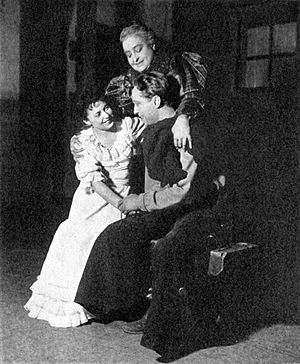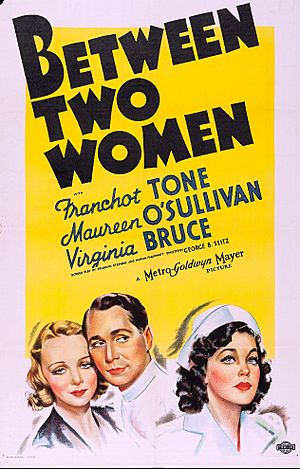Franchot Tone facts for kids
Quick facts for kids
Franchot Tone
|
|
|---|---|
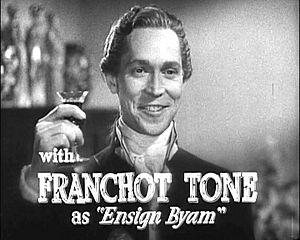
Mutiny on the Bounty
screenshot from the 1935 trailer |
|
| Born |
Stanislaus Pascal Franchot Tone
February 27, 1905 Niagara Falls, New York, U.S.
|
| Died | September 18, 1968 (aged 63) New York City, U.S.
|
| Alma mater | Cornell University |
| Occupation |
|
| Years active | 1926–1968 |
| Spouse(s) |
Jean Wallace
(m. 1941; div. 1948)Barbara Payton
(m. 1951; div. 1952)Dolores Dorn
(m. 1956; div. 1959) |
| Children | 2 |
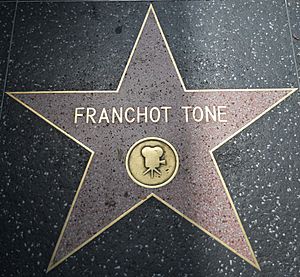
Stanislaus Pascal Franchot Tone (born February 27, 1905 – died September 18, 1968) was an American actor, producer, and director. He worked in theater, movies, and television. In the 1930s and early 1940s, he was a popular leading man. He was known for playing sophisticated gentlemen. Later, in the 1950s, he took on supporting roles.
Tone acted in many types of films. These included romantic movies and noir films. He also appeared in World War I movies. He was a guest star on famous TV shows like The Twilight Zone. He also appeared on The Alfred Hitchcock Hour. He kept acting and producing in theater and movies until the late 1960s.
Tone was nominated for an Academy Award for Best Actor. This was for his role as Midshipman Roger Byam in Mutiny on the Bounty (1935). His co-stars Clark Gable and Charles Laughton were also nominated. This was the only film where three actors were nominated for Best Actor at the same time. This led to the creation of the Academy Award for Best Supporting Actor award.
Contents
Early Life and Education
Franchot Tone was born in Niagara Falls, New York. He was the youngest son of Dr. Frank Jerome Tone. His father was a rich president of the Carborundum Company. His mother, Gertrude Van Vrancken Franchot, came from a well-known family. Tone was also related to Wolfe Tone, who is famous in Irish Republicanism. His family had French Canadian, Irish, and English roots.
Tone went to The Hill School in Pottstown, Pennsylvania. He was asked to leave for "being a subtle influence for disorder." After that, he went to Cornell University. There, he was the president of the drama club. He acted in plays by Shakespeare. He also joined the Sphinx Head Society and the Alpha Delta Phi fraternity. After graduating in 1927, he decided to become an actor. He moved to Greenwich Village, New York, to start his theater career.
Franchot Tone's Acting Career
Broadway Beginnings (1927–1932)
Tone started his acting career on Broadway. He appeared in plays like The Belt (1927) and Centuries (1927–28). He also acted in The International (1928). A popular play he was in was The Age of Innocence (1928–29) with Katherine Cornell.
He then performed in Uncle Vanya (1929) and Cross Roads (1929). Other plays included Red Rust (1929–30), Hotel Universe (1930), and Pagan Lady (1930–31).
Tone joined the Theatre Guild. He played Curly in Green Grow the Lilacs (1931). He even sang in this play! This play later became the famous musical Oklahoma!. Critics praised his performance. The play was a success, running for 64 shows on Broadway.
Tone was also a founder of the Group Theatre. This group included Harold Clurman, Cheryl Crawford, and Lee Strasberg. Playwright Clifford Odets said Tone was one of the most talented young actors he knew. Lee Strasberg, a director and teacher of "The Method," had acted with Tone.
These were busy years for Tone. He acted in Group Theatre productions like 1931 (1931) and Night Over Taos (1932). He also appeared in The House of Connelly (1931) and Success Story (1932). Outside the Group, he was in A Thousand Summers (1932).
Tone made his first movie, The Wiser Sex (1932). He starred with Claudette Colbert. This film was made by Paramount at their Astoria Studios.
The MGM Years (1933–1939)
Franchot Tone was the first actor from the Group Theatre to go to Hollywood. MGM offered him a movie contract. He still supported the Group Theatre financially later on.
MGM quickly gave Tone many important roles. In 1933, he was in six pre-Code films. He started with a supporting role in Today We Live. This was a romantic WWI drama. He then played the romantic lead in Gabriel Over the White House with Walter Huston. Next, he had a lead role with Loretta Young in Midnight Mary.
Tone also starred with Miriam Hopkins in The Stranger's Return. He was the male lead in Stage Mother. He also had a role in Bombshell with Jean Harlow. His last film in this series was Dancing Lady. In this movie, he was part of a love triangle with his future wife, Joan Crawford, and Clark Gable.
Twentieth Century Pictures borrowed Tone for Moulin Rouge (1934). He starred with Constance Bennett. The New York Times praised his "clever" performance. Back at MGM, he again co-starred with Crawford in Sadie McKee (1934). Then, Fox borrowed him for The World Moves On (1934) with Madeleine Carroll.
After The Girl from Missouri (1934) with Harlow, MGM gave Tone top billing in Straight Is the Way (1934). This was a "B" film, meaning it had a lower budget. Warner Bros. then borrowed him for Gentlemen Are Born (1934).
At Paramount, Tone co-starred in the hit movie The Lives of a Bengal Lancer (1935) with Gary Cooper. He was top-billed in One New York Night (1935). He supported Crawford and Robert Montgomery in No More Ladies (1935). He also had a big success with Mutiny on the Bounty. For this film, he was nominated for an Academy Award for Best Actor.
Warner Bros. borrowed him again for Dangerous (1935). He played Bette Davis's leading man. After a lead role in Exclusive Story (1935), he worked with Loretta Young again in The Unguarded Hour (1936). He also starred with Grace Moore in The King Steps Out (1936). This film was notable for the debut of a young Gwen Verdon.
Tone and Harlow co-starred again in Suzy (1936) with Cary Grant. The film was popular. Critics, however, were not very kind. The New York Times said Tone provided the "few honest moments of drama." Tone also had a supporting role in Love on the Run (1936) with Crawford and Gable.
RKO borrowed him to appear with Katharine Hepburn in Quality Street (1937). This costume drama did not make money. Back at MGM, he supported Spencer Tracy in They Gave Him a Gun (1937).
He had the main role in Between Two Women (1937). He co-starred for the last time with Crawford in The Bride Wore Red (1937). Then he joined Myrna Loy in Man-Proof (1938) and Gladys George in Love Is a Headache (1938).
In Three Comrades (1938), Tone worked with Robert Taylor and Margaret Sullavan. This film was about soldiers returning to Germany after World War I. He made Three Loves Has Nancy (1938) with Janet Gaynor. He also co-starred with Franciska Gaal in The Girl Downstairs (1938). He then starred in a "B" picture, Fast and Furious (1939), with Ann Sothern.
After his contract ended, Tone left MGM in 1939. He returned to Broadway to act in plays. He often worked with members of "the Group" and playwrights like Eugene O'Neill. He was in The Gentle People (1939) and The Fifth Column (1940).
Later Film Roles (1940–1949)
Tone signed a contract with Universal. He starred in his first Western, Trail of the Vigilantes (1940). He then supported female stars like Deanna Durbin in Nice Girl? (1941).
Tone also signed a deal with Columbia. He made two films with Joan Bennett: She Knew All the Answers (1941) and The Wife Takes a Flyer (1942).
Back at Universal, he was top-billed in This Woman Is Mine (1941). Tone went to Paramount to star in Five Graves to Cairo (1942). This was a World War II spy story directed by Billy Wilder.
He returned to MGM for Pilot No. 5 (1943). Then it was back to Universal for His Butler's Sister (1943) with Durbin.
Tone made two more films at Paramount: True to Life (1943) with Mary Martin and The Hour Before the Dawn (1944) with Veronica Lake. He had one of his best roles in Universal's Phantom Lady (1944). This was an early film noir movie, and he played a villain. His performance in Dark Waters (1944) with Merle Oberon was also impressive.
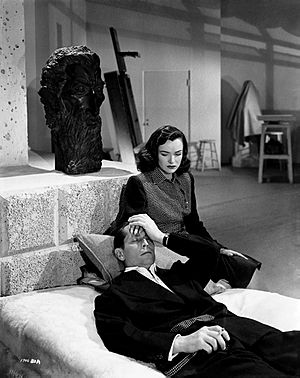
He continued his stage career. He performed on Broadway in Hope for the Best (1945).
At Universal, Tone made That Night with You (1945) with Susanna Foster and Because of Him (1946) with Durbin.
Tone made Lost Honeymoon (1947) and Honeymoon (1947) with Shirley Temple. At Columbia, he had roles in Her Husband's Affairs (1947) with Lucille Ball and I Love Trouble (1947). Then, Every Girl Should Be Married (1948) reunited him with Grant at RKO. He played a lead role as an assistant district attorney in the film noir thriller Jigsaw (1949). He also had a supporting part in Without Honor (1949).
Becoming a Producer (1949)
Tone produced and starred in The Man on the Eiffel Tower (1949). This movie had many challenges during filming. Tone played a complex character and performed many of his own stunts on the Eiffel Tower in Paris.
Burgess Meredith and Charles Laughton also starred in the film. Meredith is credited as director, but Tone took over directing when Meredith was acting. The film is known for its beautiful shots of the Eiffel Tower.
Television and Theater (1950–1959)
Tone moved to New York. He started appearing in live television shows. These included The Philco-Goodyear Television Playhouse, Lux Video Theatre, and Suspense. He returned to Hollywood for Here Comes the Groom (1951).
He continued to appear on TV shows like Lights Out and Tales of Tomorrow. But he soon went back to Broadway. He was in the hit play Oh, Men! Oh, Women! (1953–54), which ran for 400 shows. He also appeared in a revival of The Time of Your Life (1955) and Eugene O'Neill's A Moon for the Misbegotten (1957).
During this time, he also acted in TV versions of Broadway plays. He was in Twelve Angry Men. He also appeared on The Elgin Hour and The Ford Television Theatre. Tone continued to act in many other TV shows.
In 1957, Tone co-produced, co-directed, and starred in a film version of Chekhov's Uncle Vanya. His performance was highly praised.
Final Films and Television (1960–1968)
In the early 1960s, Tone appeared in episodes of Bonanza and The Twilight Zone ("The Silence"). He also acted on Broadway in Mandingo (1961). He played a dying president in the film Advise & Consent (1962).
On stage in 1963, he acted in a revival of O'Neill's Strange Interlude. He was also in Bicycle Ride to Nevada. The next year, he appeared in Double Talk.
He was cast in TV shows like The Eleventh Hour and The Alfred Hitchcock Hour. He appeared in what might be the first TV movie, See How They Run (1964).
In Europe, Tone made La bonne soupe (1965). He co-starred in the medical series Ben Casey from 1965 to 1966. He played Dr. Daniel Niles Freeland, Casey's supervisor.
He had roles in Otto Preminger's film In Harm's Way (1965). He played Admiral Husband E. Kimmel. He also appeared in Arthur Penn's Mickey One (1965). His last roles were in Shadow Over Elveron (1968) and Nobody Runs Forever (1968).
Personal Life
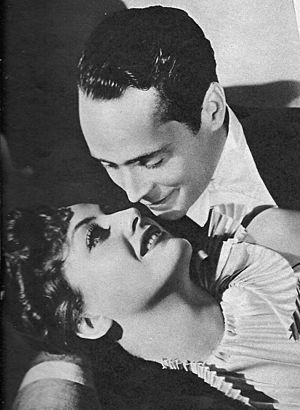
In 1935, Tone married actress Joan Crawford. They divorced in 1939. They made seven films together. These included Today We Live (1933) and Dancing Lady (1933). They did not have any children together. Tone found their divorce difficult. Years later, when Tone was very ill, Joan Crawford often took care of him. She even paid for his medical treatments.
In 1941, Tone married Jean Wallace. She was a fashion model and actress. They appeared together in Jigsaw and The Man on the Eiffel Tower. They had two sons. They divorced in 1948. Jean Wallace later married actor Cornel Wilde.
In 1951, Tone married actress Barbara Payton. They divorced in 1952.
In 1956, Tone married Dolores Dorn. They appeared together in a film version of Uncle Vanya (1957), which Tone also directed and produced. They divorced in 1959.
Death and Legacy
Franchot Tone died in New York City on September 18, 1968, from lung cancer. His ashes were kept by his son until 2022. They were then buried in Quebec, Canada.
On February 8, 1960, Franchot Tone received a star on the Hollywood Walk of Fame. This was to honor his contributions to the movie industry. His star is located at 6558 Hollywood Blvd.
Filmography
| Year | Title | Role | Notes |
|---|---|---|---|
| 1932 | The Wiser Sex | Phil Long | |
| 1933 | Today We Live | Ronnie | |
| Gabriel Over the White House | Hartley "Beek" Beekman | ||
| Midnight Mary | Thomas "Tom" Mannering, Jr. | ||
| The Stranger's Return | Guy Crane | ||
| Stage Mother | Warren Foster | ||
| Bombshell | Gifford Middleton | ||
| Dancing Lady | Tod Newton | ||
| 1934 | Moulin Rouge | Douglas Hall | |
| Sadie McKee | Michael Alderson | ||
| The World Moves On | Richard Girard | ||
| The Girl from Missouri | T.R. Paige, Jr. | ||
| Straight Is the Way | Benny | ||
| Gentlemen Are Born | Bob Bailey | ||
| 1935 | The Lives of a Bengal Lancer | Lieutenant Forsythe | |
| One New York Night | Foxhall Ridgeway | ||
| Reckless | Robert "Bob" Harrison, Jr. | ||
| No More Ladies | Jim "Jimsy Boysie" Salston | ||
| Mutiny on the Bounty | Midshipman Roger Byam | ||
| Dangerous | Don Bellows | ||
| 1936 | Exclusive Story | Dick Barton | |
| The Unguarded Hour | Sir Alan Dearden | ||
| The King Steps Out | Emperor Franz Josef | ||
| Suzy | Terry | ||
| Love on the Run | Barnabus W. "Barney" Pells | ||
| 1937 | Quality Street | Dr. Valentine Brown | |
| They Gave Him a Gun | James "Jimmy" Davis | ||
| Between Two Women | Allan Meighan | ||
| The Bride Wore Red | Giulio | ||
| 1938 | Man-Proof | Jimmy Kilmartin | |
| Love Is a Headache | Peter Lawrence | ||
| Three Comrades | Otto Koster | ||
| Three Loves Has Nancy | Robert "Bob" Hanson | ||
| The Girl Downstairs | Paul / Mr. Wagner | ||
| 1939 | Fast and Furious | Joel Sloane | |
| 1940 | Trail of the Vigilantes | "Kansas" / Tim Mason | |
| 1941 | Nice Girl? | Richard Calvert | |
| She Knew All the Answers | Mark Willows | ||
| This Woman is Mine | Robert Stevens | ||
| 1942 | The Wife Takes a Flyer | Christopher Reynolds | |
| Star Spangled Rhythm | John in Card-Playing Skit | ||
| 1943 | Five Graves to Cairo | Cpl. John J. Bramble / "Paul Davos" | |
| Pilot No. 5 | George Braynor Collins | ||
| His Butler's Sister | Charles Gerard | ||
| True to Life | Fletcher Marvin | ||
| 1944 | Phantom Lady | Jack Marlow | |
| The Hour Before the Dawn | Jim Hetherton | ||
| Dark Waters | Dr. George Grover | ||
| 1945 | That Night with You | Paul Renaud | |
| 1946 | Because of Him | Paul Taylor | |
| 1947 | Lost Honeymoon | Johnny Gray | |
| Honeymoon | David Flanner | ||
| Her Husband's Affairs | William "Bill" Weldon | ||
| 1948 | I Love Trouble | Stuart Bailey | |
| Every Girl Should Be Married | Roger Sanford | ||
| 1949 | Jigsaw | Howard Malloy | Alternative title: Gun Moll |
| Without Honor | Dennis Williams | Alternative title: Woman Accused | |
| 1950 | The Man on the Eiffel Tower | Johann Radek | Also co-producer |
| 1951 | Here Comes the Groom | Wilbur Stanley | |
| 1956 | The Little Foxes | Horace | TV Movie |
| 1957 | Uncle Vanya | Dr. Astroff | Also co-producer and co-director |
| 1958 | Bitter Heritage | Frank James | TV Movie |
| 1961 | Witchcraft | Your Host | TV Movie |
| 1962 | Advise & Consent | The President | |
| 1964 | La bonne soupe | John K. Montasi Jr. | |
| See How They Run | Baron Frood | TV Movie | |
| 1965 | In Harm's Way | Admiral Kimmel | |
| Mickey One | Rudy Lapp | Directed by Arthur Penn | |
| 1968 | Shadow Over Elveron | Barney Conners | TV Movie |
| Nobody Runs Forever | Ambassador Townsend | Alternative title: The High Commissioner, (final film role) |
Partial TV Credits
| Year | Title | Role | Episode(s) |
|---|---|---|---|
| 1954 | Studio One | Juror #3 | "Twelve Angry Men" |
| 1955 | Four Star Playhouse | Ben Chaney | "Award" |
| 1956 | General Electric Theater | Charles Proteus Steinmetz | "Steinmetz" |
| 1957 | The Kaiser Aluminum Hour | Arthur Baldwin | "Throw Me a Rope" |
| 1958 | Westinghouse Desilu Playhouse | Candy Lombe | "The Crazy Hunter" |
| 1959 | Alfred Hitchcock Presents | Oliver Mathews | "The Impossible Dream" |
| 1960 | Bonanza | Denver McKee | "Denver McKee" |
| 1961 | The Twilight Zone | Col. Archie Taylor | "The Silence" |
| 1965–1966 | Ben Casey | Dr. Daniel Niles Freeland | 27 episodes |
| 1964 | The Alfred Hitchcock Hour | The Great Rudolph | "The Final Performance" |
| 1965 | The Virginian | Murdock | "Old Cowboy" |
| 1967 | Run for Your Life | Judge Taliaferro Wilson | "Tell It Like It Is" |
Theater Appearances
| Date | Production | Role |
|---|---|---|
| October 19 – November 1927 | The Belt | Bunner |
| November 29–1, 928 | Centuries | Yankel |
| January 12 – February 1928 | The International | David Fitch |
| November 27, 1928 – May 1929 | The Age of Innocence | Newland Archer, Jr. |
| May 24–1, 929 | Uncle Vanya | Mikhail lvovich Astrov |
| November 11 – December 1929 | Cross Roads | Duke |
| December 17, 1929 – February 1930 | Red Rust | Fedor |
| April 14 – June 1930 | Hotel Universe | Tom Ames |
| October 20, 1930 – March 1931 | Pagan Lady | Ernest Todd |
| January 26 – March 21, 1931 | Green Grow the Lilacs | Curly McClain |
| September 28 – December 1931 | The House of Connelly | Will Connelly |
| December 10, 1931 – December 1931 | 1931 | |
| March 9, 1932 – March 1932 | Night Over Taos | Federico |
| May 24 – June 1932 | A Thousand Summers | Neil Barton |
| September 26, 1932 – January 1933 | Success Story | Raymond Merritt |
| January 5 – May 1939 | The Gentle People | Harold Goff |
| March 6 – May 18, 1940 | The Fifth Column | Philip Rawlings |
| February 7 – May 19, 1945 | Hope for the Best | Michael Jordan |
| December 17, 1953 – November 13, 1954 | Oh, Men! Oh, Women! | Alan Coles |
| January 19–30, 1955 | The Time of Your Life | Joe |
| May 2 – June 29, 1957 | A Moon for the Misbegotten | James Tyrone, Jr. |
| May 22–27, 1961 | Mandingo | Warren Maxwell |
| March 11 – June 29, 1963 | Strange Interlude | Professor Henry Leeds |
| September 24, 1963 | Bicycle Ride to Nevada | Winston Sawyer |
Radio Appearances
| Year | Program | Episode | Ref |
|---|---|---|---|
| 1936 | Lux Radio Theatre | "Chained" | |
| 1937 | Lux Radio Theatre | "Mary of Scotland" | |
| 1943 | Lux Radio Theatre | "Each Dawn I Die" | |
| 1943 | Lux Radio Theatre | "Five Graves to Cairo" | |
| 1944 | Lux Radio Theatre | "The Hard Way" | |
| 1952 | Theatre Guild on the Air | "The House of Mirth" | |
| 1953 | Broadway Playhouse | "His Brother's Keeper" |
See also
 In Spanish: Franchot Tone para niños
In Spanish: Franchot Tone para niños


